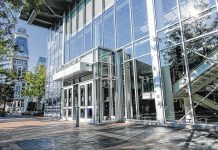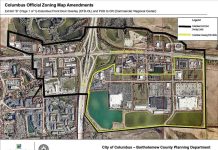INDIANAPOLIS — Cummins Inc.’s global Distribution Business finally has a permanent headquarters. But in the eyes of the diesel engine maker’s top executive, the downtown Indianapolis home base is something more significant.
“Really, for the first time we’re adding another community in Indiana,” Chairman and CEO Tom Linebarger said.
Located at 301 E. Market St. in downtown Indianapolis, the nine-story building encompasses one full city block where the former Market Square Arena — once home to the NBA’s Indiana Pacers — was located, and eventually demolished in 2001.
Columbus-based Cummins unveiled the $30 million project for one of its four core businesses — and second largest — Thursday morning during a private event.
Linebarger, Distribution Business President Tony Satterthwaite and architect Deborah Berke of Deborah Berke Partners were joined at the ribbon-cutting ceremony by Gov.-elect Eric Holcomb, Indianapolis Mayor Joe Hogsett, some current and former Cummins employees and board members, and other invited guests. They were among more than 100 people who attended the event.
“We have great roots in Columbus, that’s still our headquarters. We’ve built a number of buildings there, and that has been fantastic. But we kind of have another place in Indiana with great roots. We’ve got Seymour now, Columbus and Indianapolis,” Linebarger said.
The project, more than three years in the making, taps into the Fortune 200 company’s long history of unique architectural style started by the late J. Irwin Miller, a former company chairman and philanthropist who hired world-renowned architects to design buildings for Cummins and public buildings in Columbus.
Cummins hired New York-based Deborah Berke Partners as architect for the company’s newest building.
Berke, dean of the Yale School of Architecture, designed the Hope branch of the Bartholomew County Public Library system that opened in 1998, and also designed an Irwin Union Bank branch (now First Financial Bank) that opened in 2006 at 707 Creekview Drive in Columbus.
Company officials said their goal in the new facility was to create a warm, inviting space for employees in an architecturally-significant building.
“We tried to get three themes throughout the building: innovation, globalism and people. Those are the things we tried to put into the design and communicate in the building,” Satterthwaite said.
Features include flexible workspace, common areas, social hubs, a learning center for training and development, first-floor retail space, an energy-efficient design, a parking garage and public green space. The building — within sight of the Soldiers and Sailors Monument on the city’s circle — lies along the Indianapolis Cultural Trail, and connects with the near-east side.
The headquarters adds an urban presence to the company’s Indiana operations, which is different from Columbus, and likely will attract a different employee base, Satterthwaite said.
Also, the building uses a new concept of working space, with more openness, connectivity and flexibility.
No employee has a private office, including the executives, Satterthwaite said. For example, Satterthwaite will share an open area with Linebarger as well as the company’s chief administrative officer and vice president of strategy.
“We did a bunch of studies and found out that corporate office space is one of the most underutilized assets in the modern corporation because we all travel. We didn’t find use of that space is efficient. We’re trying to increase collaboration and increase connectivity, get people to work together more intimately. We just think tearing down the walls of offices and putting people together is a good idea,” Satterthwaite said.
The concept was piloted in Cummins’ two new downtown Columbus offices and put fully into practice in the Distribution Business headquarters, Satterthwaite said. Linebarger added that the company plans to expand the open concept to its other buildings in Columbus, such as the Corporate Office Building at 500 Jackson St. in Columbus.
Unique design
In remarks to the Indianapolis crowd, Satterthwaite recalled advice from Miller that he said still applied to the Distribution Business Headquarters project.
“Mr. Miller believed everything you do is worth doing well. He famously said that mediocrity is expensive, and it’s better to spend a little more and invest a little more and do something right the first time,” Satterthwaite said.
Cummins invited three architectural firms in July 2014 to participate in a design competition for the Distribution Business headquarters.
“Winning the competition to design this building is one of, if not the highlight, of my career to date. It means to lot to work for Cummins. As a company they are, and have been, one of the great patrons of American architecture,” Berke said.
For the competition, Cummins described its project broadly as needing flexible workspaces, a variety of opportunities to both collaborate and work individually, opportunities for teaching and education, and a contribution to the city of Indianapolis, Berke said.
She added that her design team decided the building needed to be tall — with smaller floors and more stories — and with lots of natural light.
The exterior glass facade is calibrated in a way to account for how the sun moves during day and throughout the year, and vertical fins moderate heat gain and glare while maximizing the amount of daylight, Berke said.
“Cummins understands that a healthy work environment is healthy for the employees and healthy for the company,” Berke said.
Another aspect of creating a healthy work environment was incorporating art. The building features three commissioned pieces and about 60 other works by artists from Indiana and other states.
The lobby features a red, wire frame sculpture of Cummins’ QSK50 Drilling Engine. Satterthwaite said the company wanted something that rivaled the exploding engine sculpture located at the Corporate Office Building in Columbus.
On the first level facing Market Street is a commissioned work “Big Bright Steel Cummins Inc.” by Emily Kennerk and Jennifer Riley, the wife of T. Kelly Wilson, director of the IU Center for Art + Design Columbus. The piece uses steel remnants from Cummins fabrication partner Noblitt Fabrications of Columbus.
The second floor features a town square concept, that includes tables and chairs near a kitchen area, open community spaces for collaboration and even smaller quiet spaces in the only square area of the building. Rooms for training and meetings branch off the square.
The concept of connectivity is incorporated into upper levels, as Floors 3 and 4 are connected by stairs, as are 5 to 6, and 7 to 8. Each floor features a variety of spaces to work as one needs, ranging from open desk areas to couches to small focus rooms to cushion seating space on wide stairs. Floors also feature a variety of conference spaces, from small to large.
Will Miller, son of the late J. Irwin Miller and a Cummins board member, said he liked the amount of natural light in the building, and added that the headquarters reflects the architectural tradition that his father started.
“My hope is that he would feel it is a reflection of the philosophy that he inherited from his ancestors and articulated in hopes that it would inspire subsequent generations,” Miller said.
Location, space meet needs
The Distribution Business, which moves engines, services and support from one place to another, didn’t have a home base like the other core segments. Engine and Components are based in Columbus, while Power Systems in based in Fridley, Minnesota.
Cummins officials said a headquarters in downtown Indianapolis provides a location closer to distributors and customers through its proximity to Indianapolis International Airport and access to multiple interstate highways.
Cummins officials have stressed that its global headquarters will remain in Columbus, where the company was founded 98 years ago.
Top executives, such as Linebarger, will have offices in both Columbus and and the new Distribution headquarters, Cummins spokeswoman Katie Zarich said.
The new building consolidates two Cummins downtown Indy offices — Capital Center North and One America Tower, both on Illinois Street — where more than 100 employees worked.
The Distribution headquarters has workspace for 450 employees and about 350 will work there to start. About 125 jobs that have been located in Columbus will now work from the Distribution headquarters in Indy.
Employees will move in during the next three weeks, beginning next week, Satterthwaite said.
Distribution leaders and many that support the business will work from the headquarters. In addition, others who work in corporate functions such as corporate communications, legal, security, ethics and compliance will work from the new building, too.
Cummins has about 10,000 employees in Indiana, and more than 8,000 work in Bartholomew County.
[sc:pullout-title pullout-title=”Timeline” ][sc:pullout-text-begin]
2013: Cummins Inc. reaches out to city officials in Indianapolis and indicates the company is looking at multiple locations for relocation of its distribution business headquarters.
March 2014: Cummins announces it will build a $30 million headquarters for its global distribution business in downtown Indianapolis, while maintaining its corporate headquarters in Columbus.
July 2014: Cummins announces design competition among three New York-based architectural firms to create a world-class headquarters for its global distribution business in downtown Indianapolis.
September 2014: Deborah Berke Partners chosen to build the company’s Distribution Business headquarters.
December 2014: Cummins unveils plans for the headquarters. They include a high-rise office tower, retail on the first floor, a large public greenspace, flexible office space, a progressive look, abundant views and natural light.
April 2015: Cummins breaks ground on its new downtown Indianapolis headquarters for its global Distribution Business.
January 2017: Cummins unveils the new Distribution Business headquarters to the media and invited guests in a private event.
[sc:pullout-text-end][sc:pullout-title pullout-title=”By the numbers” ][sc:pullout-text-begin]
Some numerical facts about Cummins Inc.’s new Distribution Business global headquarters in downtown Indianapolis.
1: Size of the property in city blocks that it covers.
3: Number of architectural firms that participated in a design competition for the right to design the headquarters. Also the number of commissioned artworks for the building.
3.3: Amount of money, in millions, that Indianapolis contributed for infrastructure improvements — such as sidewalks, curbs and parking.
4: Size in acres of the property on which it is built.
9: Height in stories.
30: Cost in millions for the headquarters project.
60: Estimated number of individual works of art displayed throughout the building.
70: Percentage of property tax abatement that Cummins received from Indianapolis for a 10-year period for the building.
301: Address on East Market Street for the building.
350: Number of employees that will be in the building when it opens.
450: Maximum number of employees it can accommodate.
164,000: Size of the building in square feet, excluding first-floor retail space.
[sc:pullout-text-end][sc:pullout-title pullout-title=”What others say” ][sc:pullout-text-begin]
“What I find the most interesting out of the remarks is how proud Indianapolis is to have a building that connects back to Columbus’ legacy, and I think that is a really important point.”
— Richard McCoy, director of Landmarks Columbus, which cares for and celebrates the design heritage in Columbus
——————————————-
“Today is obviously only possible because of Cummins’ decades-long commitment not only to our community but to communities all around the world.”
— Gov.-elect and current Lt. Gov. Eric Holcomb
——————————————-
“We gather here to mark not just the opening of a building but a destination point for the city of Indianapolis. It is indeed grand in its architectural achievement and prolific in its impact for our skyline and our community.”
— Indianapolis Mayor Joe Hogsett
——————————————-
“I like to think we have reached a point in our evolution that we, too, are determined and have a confidence to carefully create a skyline that we use to define ourselves by its world-class architecture. And, I’d like to think we’re standing in a perfect example right now.”
Vop Osili, Indianapolis city-county councilman and architect
[sc:pullout-text-end]




